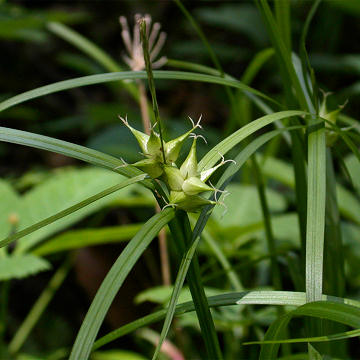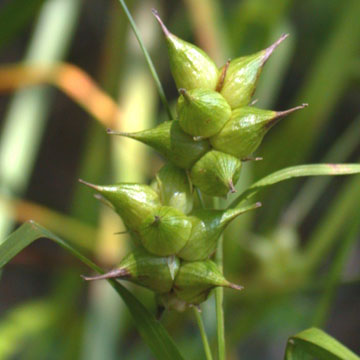

Carex intumescens - (image 1 of 6)
Taxonomy
Family: Cyperaceae
Habitat
Moist or wet woods, mesic swamps, moist acidic prairies, hemlock swamps.
Associates
Distribution
Newfoundland west to southeast Manitoba, south to FL and TX.
Morphology
Perennial to 0.9 m, evergreen; stems solitary or in small clusters, purplish at the base, somewhat rough-margined; leaves and leaf sheaths septate-nodulose; leaves 4-6 mm wide, somewhat scabrous; front of sheath with a whitish band with a brown, concave summit; ligule rounded; bracts exceeding the inflorescence; male spikelet stalked, female spikelets 1-3, globose, about 3 cm in diameter; perigynia 10-16 mm long, ribbed, inflated, ovoid and rounded at the base, shiny-smooth, the beak wedge-tapered; scales sometimes awned, ovate to lanceolate, less than 12 per spikelet; stigmas 3; achenes trigonous, sharply angled with flat to concave sides; style slightly curved, persistent.
Notes
Fruiting late May to July
Wetland indicator: FACW
Rare in the Chicago Region, most of these plants were photographed in a moist woodland in central NY. This species is similar to C. grayi Rudge. Two other species, C. lupuliformis and C. lupulina also have inflated perigynia over 10 mm long but are more thin-tapered.
Southern plants tend to be more robust and have more inflated, ovoid perigynia and have been called var. fernaldii L.H. Bailey. The photo below is an example of one such plant photographed in southern NJ.

References
Curtis, L. 2006. Woodland Carex of the upper Midwest. Lake Villa, IL.
Gleason, Henry A. and A. Cronquist. 1991. Manual of Vascular Plants of
Northeastern United States and Adjacent Canada. Second Ed.
The New York Botanical Garden. Bronx, NY
Swink, F. and G. Wilhelm. 1994. Plants of the Chicago Region.
Indiana Academy of Science. The Morton Arboretum. Lisle, Illinois.
|
© Michael Hough 2009 |